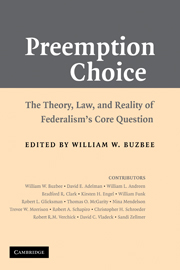Book contents
- Frontmatter
- Contents
- Contributors
- Acknowledgments
- Introduction
- Part I FEDERALISM THEORY, HISTORY, AND PREEMPTION VARIABLES
- Part II THE LAYERED GOVERNMENT NORM
- Part III JUDICIAL TREATMENT AND INTERPRETIVE CHOICE
- Part IV PREEMPTION TALES FROM THE FIELD
- 11 The Regulation–Common Law Feedback Loop in Nonpreemptive Regimes
- 12 Delegated Federalism Versus Devolution: Some Insights from the History of Water Pollution Control
- 13 Adaptive Environmental Federalism
- Conclusion: The Menu of Preemption Choice Variables
- Index
Conclusion: The Menu of Preemption Choice Variables
Published online by Cambridge University Press: 07 July 2009
- Frontmatter
- Contents
- Contributors
- Acknowledgments
- Introduction
- Part I FEDERALISM THEORY, HISTORY, AND PREEMPTION VARIABLES
- Part II THE LAYERED GOVERNMENT NORM
- Part III JUDICIAL TREATMENT AND INTERPRETIVE CHOICE
- Part IV PREEMPTION TALES FROM THE FIELD
- 11 The Regulation–Common Law Feedback Loop in Nonpreemptive Regimes
- 12 Delegated Federalism Versus Devolution: Some Insights from the History of Water Pollution Control
- 13 Adaptive Environmental Federalism
- Conclusion: The Menu of Preemption Choice Variables
- Index
Summary
This book's structure and chapters illuminate each actor and setting in which preemption choices must be made. Using theory, history, and legal doctrine, the book's diverse contributors also identify the menu of variables relevant to preemption choices. Rather than recount each chapter's contribution, this conclusion distills the chapters' strains and arguments to identify these variables and how they should influence preemption choice.
Preemption choice is first and foremost influenced by the Constitution's Supremacy Clause, its federalist design, and the procedures it requires for the creation of law. The Constitution undoubtedly anticipates that federal law can and will in some settings preempt contrary state law, whether it is a statute, a regulation, or common law. This capacity is inherent in federal legislative power and federal law's supremacy. But the mere possibility of federal assertion of preemptive power is distinct from the question of whether it has been asserted. As virtually all chapters explain, the dominant and most common political choice is not to preempt but to set a federal floor and “save” state and local laws that do not conflict, provided that they are at least as protective as federal law. As Professor William Andreen discusses in his analysis of the Clean Water Act's structures and history, many cooperative federalism regimes, especially in delegated program federalism schemes, explicitly retain concurrent, overlapping, and intertwined federal, state, and local roles, including preservation of common law.
- Type
- Chapter
- Information
- Preemption ChoiceThe Theory, Law, and Reality of Federalism's Core Question, pp. 301 - 304Publisher: Cambridge University PressPrint publication year: 2008
- 3
- Cited by

